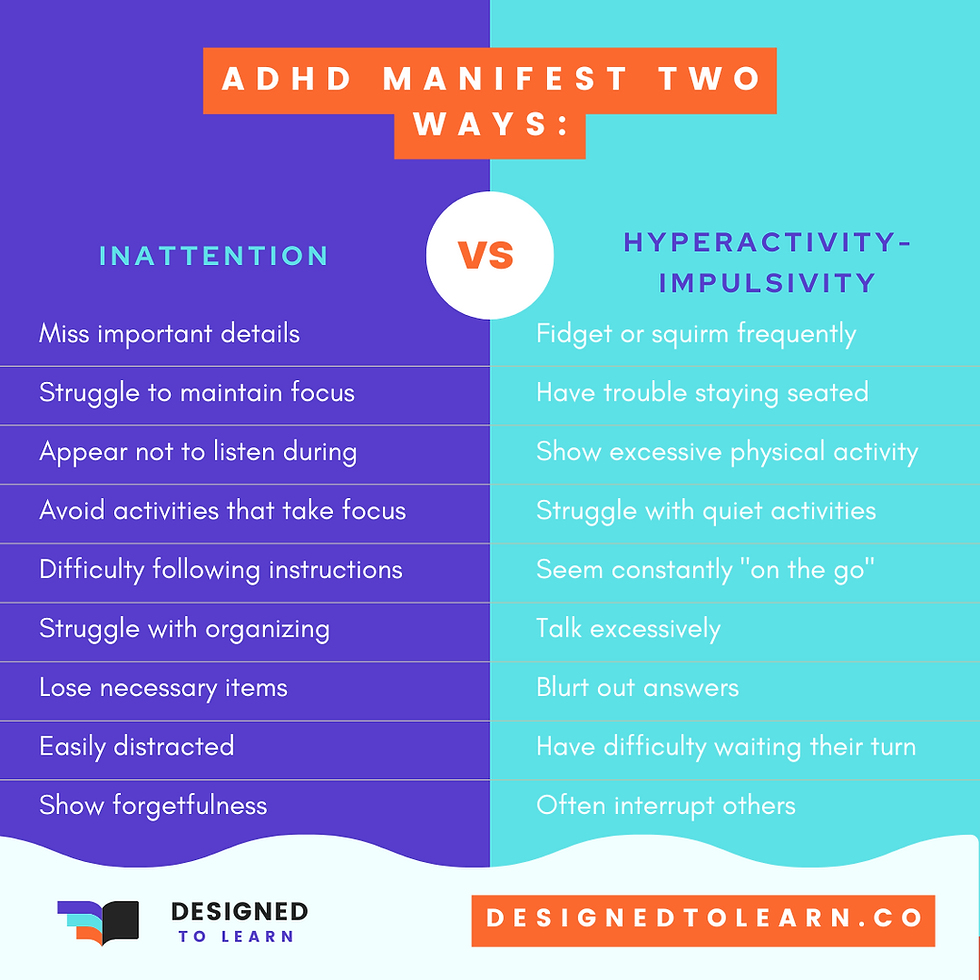When ADHD and Dyslexia Intersect: A Guide for Parents and Educators
- Designed to Learn
- Oct 27, 2024
- 3 min read
We frequently work with students who face multiple learning challenges. One common combination that we encounter is the co-occurrence of ADHD (Attention-Deficit/Hyperactivity Disorder) and dyslexia. Approximately 30% of learners with dyslexia also have ADHD. Understanding how these conditions interact is crucial for providing effective support to these learners.
Understanding ADHD: Beyond "Just Can't Sit Still"
ADHD is a neurodevelopmental condition that affects how individuals manage attention, activity levels, and impulse control. While many people associate ADHD with hyperactive children, the reality is more complex. The condition manifests in two primary ways:

Students with inattentive ADHD often:
- Miss important details in their work
- Struggle to maintain focus during lessons or while reading
- Appear not to listen during direct instruction
- Have difficulty following multi-step instructions
- Struggle with organizing tasks and materials
- Avoid activities requiring sustained mental effort (like reading or homework)
- Frequently lose necessary items
- Are easily distracted by external stimuli
- Show forgetfulness in daily activities
Students with hyperactive-impulsive ADHD typically:
- Fidget or squirm frequently
- Have trouble staying seated
- Show excessive physical activity
- Struggle with quiet activities
- Seem constantly "on the go"
- Talk excessively
- Blurt out answers
- Have difficulty waiting their turn
- Often interrupt others

Professional who evaluate students for ADHD, may consider several key factors:
1. Symptom Duration: Symptoms should be present for at least six months
2. Cross-Setting Occurrence: Behaviors should appear in multiple environments (home, school, etc.)
3. Impact on Daily Life: Symptoms must significantly affect major life activities
4. Early Onset: Signs should be present by age 7
5. Developmental Appropriateness: Behaviors must be evaluated in the context of age-appropriate expectations
The Learning Difference vs. ADHD Connection
One crucial point we emphasize to parents and educators: If attention issues only appear in school settings, we might be looking at a learning difference rather than ADHD. When students struggle to learn effectively, they may display ADHD-like behaviors as a response to their frustration or difficulty with the material.
Supporting Students with Co-occurring ADHD and Dyslexia.
Students with both ADHD and dyslexia often bring creativity, imagination, and empathy into their learning experiences, yet they also need structured support to perform well academically. Recognizing their strengths and using a multifaceted support approach can make a significant difference. For instance, some students excel when they can hold and manipulate flashcards during review. Others may thrive by working towards a set reward. Supporting these learners often involves a bit of trial and error and thinking outside the box to find what works best for them.
Here are a few of found that supporting these students requires a multi-faceted approach:
1.Structured Learning Environment
- Clear routines and expectations
- Organized workspace
- Minimal distractions
2. Multi-Sensory Instruction
- Engaging multiple senses helps maintain attention
- Hands-on activities support learning retention
- Movement-based learning activities
3. Breaking Down Tasks
- Divide assignments into manageable chunks
- Provide clear, step-by-step instructions
- Use checklists and visual aids
4. Regular Breaks
- Incorporate movement breaks
- Allow for "brain breaks" during challenging tasks
- Use timer systems for focused work periods

If you're interested in exploring this topic further, this conversation with Dr. Jack Fletcher discusses the importance to remediating for both dyslexia and ADHD.
Working Together for Success
Supporting students with both ADHD and learning differences requires collaboration between parents, teachers, and specialists. By understanding how these conditions interact and implementing appropriate strategies, we can help these students succeed in their learning journey.
Remember: Every student is unique, and what works for one may not work for another. The key is to remain patient, observant, and flexible in our approach while maintaining high expectations for their success.
---
Are you a parent or educator working with a student who has ADHD and dyslexia? We’d love to hear about your experiences and strategies in the comments below.
This post is a part of a miniseries Beyond Dyslexia: Understanding Co-Occurring Conditions during our 31 Days of Dyslexia series, offering practical insights for educators and parents. Subscribe and follow along to learn more strategies that can make a difference in the lives of dyslexic learners!

Comments